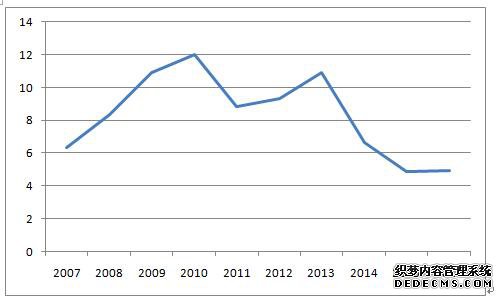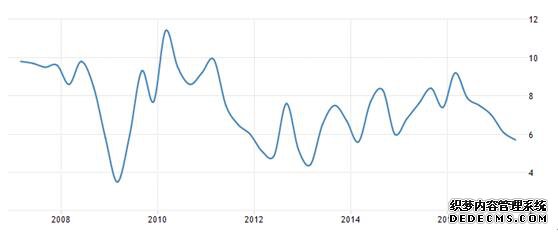|
通货膨胀作为政府宏观调控的基本目标之一,其形成的原因和未来不仅关系到经济的可持续增长,而且关系到社会的稳定和政治的稳定。自1991年改革以来,印度的经济增长一直保持着快速发展的势头,近十年的商业增长率从7%提高到8%,高达9%,与中国、巴西、俄罗斯等著名的“砖头”国家相提并论。但在经济飙升之后,出现了严重的通货膨胀现象。在新一轮的全球通胀中,印度在2004年,中国在2007年初有所增加,因此政府在早些时候采取措施遏制通胀,并取得了具体成果。本文在分析印度经济增长现状及原因的基础上,分析了印度政府抑制通货膨胀的标准(Kumar&Sahu,2017)。
Inflation, as one of the essential goals of government's macro-regulation, its forming reason and the future is not only related to the sustainable economic growth, also associated with social stability and political stability. Since reform in 1991, India's economic growth has been maintaining the momentum of rapid development, nearly ten years of commercial increase from 7% to 8%, up to 9%, with China, Brazil, Russia famous as the "brick" countries. But after the economic surge, there is a severe inflation phenomenon. In the new round of global inflation, India in 2004, increase in China early in 2007, so the earlier, the government take measures to curb inflation and achieved specific results. Based on the analysis of the current situation and causes of increase in India, this paper analyzes the standards of the Indian government in restraining the inflation process (Kumar &Sahu, 2017).
Inflation rates of India from 2007 to 20162007-2016年印度通货膨胀率
  Figure 1: Inflation rates of India from 2007 to 2016 (Source from World Bank)
As can be seen in the Figure 1, the inflation rate is as higher as 12% in 2010, the rate decreased from 2013, so that inflation rates are keep down.

Figure 2: the annual GDP growth rate of India from 2008 to 2017
Figure 2 has demonstrated that the highest growth year is 2010.
There are three causes of inflation: a change in currency values, or too much money chasing also few goods. It is a monetary phenomenon. The increase is a monetary phenomenon on the surface. One is the imbalance of supply and demand caused by the exchange of price is higher than the production price phenomenon, so this is just a temporary phenomenon of inflation (Chowdhury, 2014). Wait until after the balance of supply and demand; prices will return to the previous production. Monetary policy is effective against the above two phenomena, and the last is the inflation caused by redistribution of wealth, which illustrated as the cost increase. Monetary policy is generally ineffective because money is only a shadow of wealth and is not wealth itself.
The excess liquidity relied on traditional economic theory. There are many types of inflation, including demand pull, cost push, structural and monetary inflation, etc. In fact, whatever the causes, the increase linked to the money supply.
India has long attached importance to the development of heavy industry and services, and agricultural progress has been slow. In the year of crop failure, annual price increases are higher; On the other hand, the yearly rate of agrarian harvest is low. India's inflation rose to 7.51% in 2004 from 6.52% a few weeks ago, as a result of drought in India's central food-producing region. In June 2009, India had its worst drought in 1983 years of weather, directly caused the crops such as rice, sugar and potato plants, in rice, sugar beet and rapeseed and other agricultural prices hit 11-year highs. In contrast to both manufacturing and services, India's agriculture sector grew by only 2.5% in 2007. India is the most significant country in Asia with 160 million hectares of arable land (Behera, Pattanaik&Kavediya, 2017). But Indian food production is not high, China's arable land is 128 million hectares, just 80 percent of India's, but in 2008 China produced more than 500 million tons of grain, compared with India's 230 million tons. India now has only 40 percent of its farmland, with 60 percent depending on the weather. Indian government economic policy in recent years many cities as the center, a severe shortage of agricultural inputs, grain farmers' enthusiasm is not high; there are large Numbers of the rural labor force from agriculture to withdraw. As a result, India's high inflation rate is primarily due to a weak harvest in agriculture.
The rise in international crude prices. The rising global oil price is one of the most critical factors contributing to India's rising inflation, according to Indian authorities. India produces far more oil each year than it needs, plus its strategic oil reserves, which depend on imports for 70% of its annual total. At one point, international oil prices climbed to $80 a barrel at the end of 2009, more than double the lows of 2009. Rising oil prices have not only led to higher costs for India's energy imports, but other oil-gas-related products have also followed suit, leading to higher inflation.
Dollar QE continues. The fed implemented its first round of quantitative easing in March 2009, and the second round of quantitative easing in November 2010 led to a sustained decline in the value of the dollar. The decrease in the dollar has led to a rise in the Indian rupee. Although currency appreciation after import prices lower is beneficial to reduce the pressure on inflation, on the other hand, rapid currency appreciation is expected to lead to international capital flows, passive increase money supply, increasing the strength of boom. Also, the depreciation of the dollar has led to a rise in global commodity prices priced in dollars, which in part offset the lower cost of imported goods from the Indian rupee.
One is monetary policy: the reserve bank of India (rbi), the reserve bank of India (rbi), has raised interest rates eight times since 2010, with repo rates and reverse repo rates rising to 6.25 percent and 5.25 percent respectively. Secondly, the fiscal policy: from the end of 2006, the Indian government has taken various measures, to curb inflation.first of all, reduce manufacturing cost and promote the construction of infrastructure, to reduce the support such as agricultural products and cement raw material import (SaiVivek&RaghavenderRaju, 2014). To lower the price of fuel, its the ban on wheat and grain produce long-term speculative trading and banned wheat exports in early 2007. Third, to increase social spending power, India has grown government staff subsidies, oil and fertilizer subsidies, and the national agricultural employment guarantee program and the reduction of farmers' debts.
References
Behera, H. K., Pattanaik, S., &Kavediya, R. (2017). Natural interest rate: Assessing the stance of India’s monetary policy under uncertainty. Journal Of Policy Modeling, 39(3), 482-498.doi:10.1016/j.jpolmod.2017.03.002
Chowdhury, A. (2014). Inflation and inflation-uncertainty in India: the policy implications of the relationship. Journal Of Economic Studies, 41(1), 71-86.doi:10.1108/JES-04-2012-0046
Garriga, C., Kydland, F. E., &Šustek, R. (2017).Mortgages and Monetary Policy. Review Of Financial Studies, 30(10), 3337-3375.doi:10.1093/rfs/hhx043
Kumar, K. K., &Sahu, B. (2017). Dynamic Linkages Between Macroeconomic Factors And Islamic Stock Indices In A Non-Islamic Country India. Journal Of Developing Areas, 51(1), 193-205.
SaiVivek, W., &RaghavenderRaju, G. (2014). Monetary Policy Transmission in India: A Post-Reform Analysis. IUP Journal Of Applied Economics, 13(2), 7-22.
|
 |
|||
| 网站地图 |

